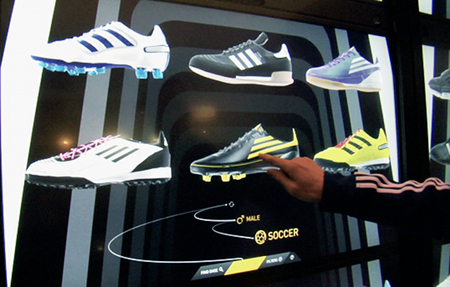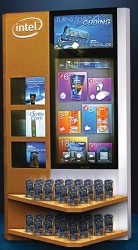Retail show mixes Minority Report with bread and butter
Jan 17, 2011 — by LinuxDevices Staff — from the LinuxDevices Archive — viewsIntel used the National Retail Federation show in New York to push cutting-edge technology. Meanwhile, Microsoft, Dell and a multitude of other IT vendors all showcased more workaday hardware, software and services.
If you're a man or woman, young or old, a runner, a soccer player or just a casual sports fan, Intel and Adidas have the perfect pair of shoes for you. As long as you don't mind that you're looking at a pair of virtual shoes — the companies' real ones are probably somewhere in the storeroom.

The "Adiverse" virtual sneaker display from Adidas
Source: Fast Company
This new vision of retail, which combines semiconductor technology, video analytics and old-fashioned brick-and-mortar sales, could be found at the National Retail Federation Convention and Expo, which kicked off Jan. 9 at the Jacob K. Javits Convention Center in New York.
While the NRF show usually focuses on the latest trends in retail, IT companies had a significant presence this year, which many agreed was a big improvement, compared with last year's expo, when companies were still recovering from the recession and poor sales. Companies such as Microsoft, IBM, Oracle, Motorola, Intel and Hewlett-Packard dominated the showroom floor with big displays to show how technology can make retail more profitable.
One of the more impressive displays on the floor belonged to Intel, which partnered with the likes of Adidas and Kraft Foods to show how technology and commerce can converge within the retail space. The chipmaker's exhibitions showed embedded devices featuring the company's recently introduced "Sandy Bridge" Core processors, which combine CPU and graphics technology on a single piece of silicon. (See our previous coverage for complete details.)
"What we want to do is bring the best of online into the brick-and-mortar stores," said Chris O'Malley, director of Intel's retail marketing, adding that, in addition to chips, Intel is looking to bring technology such as vPro into retail as a way to manage POS (point-of-sale) machines and other equipment.
"If a digital sign crashes, it could sit there for three to four hours before someone tries to get it fixed," O'Malley said. "With something like vPro, the signal is sent, and a sign or a POS machine can be restarted or reimaged."
The Sandy Bridge processors and vPro have been combined with new technology that Intel is developing called anonymous video analytics, which work with large, touch-screen displays that can identify people by their gender and age. Intel had been developing this AIM (Anonymous Impression Metric) platform, when it bought a small Canadian digital-signage company called CognoVision late last year.
For Kraft, this new technology means a retail display that can not only tell a shopper what is on his or her grocery list; it also can suggest recipes based on both a person's gender, age and what is on that weekly shopping list. Of course, there is also a social-media component that allows people to share and "like" recipes on Facebook.
While the Kraft display is still proof-of-concept technology, the Adidas display is moving closer to reality. "Adiverse," pictured earlier in this story, uses a huge touch-screen to let customers see and get information on thousands of pairs of shoes, is expected to move toward a pilot program later this year.
The screen allows the customer to customize the shoes they are looking for by price, size, color and even what sport the footwear is designed for. Once the customer selects a shoe, the information is sent to an employee with a tablet who can retrieve the item from a storeroom.
 Intel also showed off a Digital Signage Endcap Concept (right) co-developed with Procter and Gamble. As a consumer comes within ten feet of the endcap, sensors pick up their presence, gender, and approximate age. When products are picked up off the shelves, digital signs magnify the product on screen and provide additional information, the company adds.
Intel also showed off a Digital Signage Endcap Concept (right) co-developed with Procter and Gamble. As a consumer comes within ten feet of the endcap, sensors pick up their presence, gender, and approximate age. When products are picked up off the shelves, digital signs magnify the product on screen and provide additional information, the company adds.
According to Intel, the Digital Signage Endcap Concept includes a computer using a Sandy Bridge Core CPU, two 32-inch displays on either side of the endcap, two 55-inch displays, and three shelves with 10-inch screens and RFID capabilities. It has the capability to send e-coupons to consumers' smartphones, the company adds.
For now, touchscreens like those Adidas and Kraft are using are rapidly close to reality. However, Intel is also looking to offer displays with hands-free gesture technology that will allow customers to browse products from several feet away or even outside the store. However, at the Intel booth, a brief, hands-on demonstration using shaving products for men showed that the technology needs to be improved before it can be deployed.
A video of Adidas' Adiverse display
Source: Fast Company
More down-to-earth product offerings
If Intel's display was a "Minority Report," then Dell was more bread-and-butter. At its booth, Dell had all the familiar trappings of the NRF show: POS machines, IP video cameras for security and digital signs.
However, Dell was pushing its wares in two specific directions. The first targeted small and midsized retail stores, which Dell translates into any company with 10 to 100 retail shows, and the second is IT services. For the better part of two years, Dell has pushed its SMB and IT services as the company looks to reinvent itself, and now that same focus is coming to vertical markets, such as retail.
Brian Slaughter, director of end-user solutions for Dell's Large Enterprise division, believes that the company's acquisitions, such as Kace Networks and Perot Systems, have helped the PC maker expand its operations. The Kace buy allows Dell to offer device-management capabilities to retail stores. Perot, which did not have a specific retail division, helps Dell integrate software, such as SAP applications, across its retail offerings, said Slaughter.
Microsoft, meanwhile, used NRF to announce its new Windows Embedded Handheld 6.5 operating system and to unveil a technology preview of Windows Embedded POSReady 7. It also showed off Microsoft Dynamics AX for Retail and Microsoft Dynamics CRM software with the aid of partners such as Aladata Solution, Avande, HCL Technologies, and Retaligent Solutions.
Background
This year marked the 100th for the NRF convention, described by its organizers as "the world's leading retail event, bringing 18,500 retail executives and vendors from more than 50 countries together." Of more than 600 exhibitors, the majority were outside the IT industry, but heavy-hitters such as Cisco, Fujitsu, Honeywell, IBM, NCR, Wincor Nixdorf, and many others were all represented.
Scott Ferguson is Managing Editor, East Coast, of eWEEK.
This article was originally published on LinuxDevices.com and has been donated to the open source community by QuinStreet Inc. Please visit LinuxToday.com for up-to-date news and articles about Linux and open source.